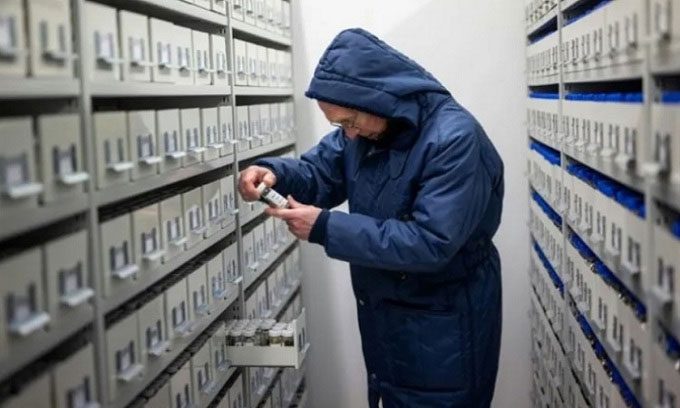The cold storage bomb shelter in the English countryside conceals a treasure trove of 40,000 types of wild plant seeds from around the world, including many species at risk of extinction.
The world’s largest seed bank, located in the countryside south of London, is racing against time as 2 out of every 5 plant species are threatened with extinction. Renowned British naturalist David Attenborough has remarked that the Millennium Seed Bank (MSB) “may be the most important conservation initiative ever.”

Seed shelves from around the world in the MSB storage facility. (Photo: AFP).
According to John Dickie, the project research leader, the goal of their work is to preserve wild plant species through seeds, preventing long-term extinction risks. He has been involved with the MSB project since its inception in the late 1990s and opened the current facility in 2000 to commemorate the millennium.
In total, 2.5 billion seeds are stored at the MSB in Wakehurst, located 56km from London, and at a branch of the Kew Gardens in the capital. They come in various shapes, colors, and sizes, representing 40,020 different species sourced from 190 countries.
Nearly 20% of the world’s plants are conserved at Wakehurst, with a focus on threatened species, particularly those impacted by climate change, as well as endemic plants that exist only in specific geographical areas. Plants that serve medicinal purposes or have economic value are also prioritized. “Many plant species are becoming endangered for various reasons, but primarily due to land use changes and climate change. Some species will adapt. Others will not be able to. At least they are here rather than being extinct,” Dickie shared.
Wakehurst receives new seeds from around the world every week, and the preservation process begins. This process relies on technology previously applied to various crops. After drying and freezing, seeds can be stored for decades, even centuries.
Dickie’s team consists of about 20 researchers and many volunteers working in the lab. One of them is Lucy Taylor, who is working with seeds of the Albizia polyphylla tree from Madagascar. Her work involves separating empty seeds from viable ones. “Many seeds are shriveled or infected with pests, so cleaning the seeds as much as possible is crucial. We want to have the best quality collection since space in the storage facility is limited,” Taylor noted.
Researchers X-ray the seeds to check for diseases, and each seed is tagged with its name, origin, and date of arrival at the MSB. They then store the seeds in glass jars before placing them in a cold storage vault at -20 degrees Celsius underground, designed to withstand flooding, bombs, and radiation. The largest seed collection comes from the orchid family. However, there are also rare plants, such as the smallest water lily in the world and Deschampsia antarctica, one of only two flowering plant species native to the Antarctic continent.


















































